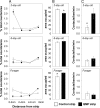Peripheral modulation of worker bee responses to queen mandibular pheromone
- PMID: 19934051
- PMCID: PMC2791564
- DOI: 10.1073/pnas.0907563106
Peripheral modulation of worker bee responses to queen mandibular pheromone
Abstract
It is generally accepted that young worker bees (Apis mellifera L.) are highly attracted to queen mandibular pheromone (QMP). Our results challenge this widely held view. We have found that unless young workers are exposed to QMP early in adult life, they, like foragers, avoid contact with this pheromone. Our data indicate that responses to QMP are regulated peripherally, at the level of the antennal sensory neurons, and that a window of opportunity exists in which QMP can alter a young bee's response to this critically important pheromone. Exposing young bees to QMP from the time of adult emergence reduces expression in the antennae of the D1-like dopamine receptor gene, Amdop1. Levels of Amdop3 transcript, on the other hand, and of the octopamine receptor gene Amoa1, are significantly higher in the antennae of bees strongly attracted to QMP than in bees showing no attraction to this pheromone. A decline in QMP attraction with age is accompanied by a fall in expression in worker antennae of the D2-like dopamine receptor, AmDOP3, a receptor that is selectively activated by QMP. Taken together, our findings suggest that QMP's actions peripherally not only suppress avoidance behavior, but also enhance attraction to QMP, thereby facilitating attendance of the queen.
Conflict of interest statement
The authors declare no conflict of interest.
Figures





Similar articles
-
Juvenile hormone enhances aversive learning performance in 2-day old worker honey bees while reducing their attraction to queen mandibular pheromone.PLoS One. 2014 Nov 12;9(11):e112740. doi: 10.1371/journal.pone.0112740. eCollection 2014. PLoS One. 2014. PMID: 25390885 Free PMC article.
-
cGMP modulates responses to queen mandibular pheromone in worker honey bees.J Comp Physiol A Neuroethol Sens Neural Behav Physiol. 2011 Sep;197(9):939-48. doi: 10.1007/s00359-011-0654-5. Epub 2011 May 31. J Comp Physiol A Neuroethol Sens Neural Behav Physiol. 2011. PMID: 21626397 Free PMC article.
-
Dopamine receptor activation by honey bee queen pheromone.Curr Biol. 2009 Jul 28;19(14):1206-9. doi: 10.1016/j.cub.2009.05.051. Epub 2009 Jun 11. Curr Biol. 2009. PMID: 19523830
-
The Pheromone Landscape of Apis mellifera: Caste-Determined Chemical Signals and Their Influence on Social Dynamics.Molecules. 2025 May 29;30(11):2369. doi: 10.3390/molecules30112369. Molecules. 2025. PMID: 40509256 Free PMC article. Review.
-
Cooperation, conflict, and the evolution of queen pheromones.J Chem Ecol. 2011 Nov;37(11):1263-75. doi: 10.1007/s10886-011-0036-z. Epub 2011 Nov 15. J Chem Ecol. 2011. PMID: 22083225 Review.
Cited by
-
Pheromonal Regulation of the Reproductive Division of Labor in Social Insects.Front Cell Dev Biol. 2020 Aug 20;8:837. doi: 10.3389/fcell.2020.00837. eCollection 2020. Front Cell Dev Biol. 2020. PMID: 32974354 Free PMC article. Review.
-
Two dopamine receptors play different roles in phase change of the migratory locust.Front Behav Neurosci. 2015 Mar 31;9:80. doi: 10.3389/fnbeh.2015.00080. eCollection 2015. Front Behav Neurosci. 2015. PMID: 25873872 Free PMC article.
-
Age- and behaviour-related changes in the expression of biogenic amine receptor genes in the antennae of honey bees (Apis mellifera).J Comp Physiol A Neuroethol Sens Neural Behav Physiol. 2012 Oct;198(10):753-61. doi: 10.1007/s00359-012-0745-y. Epub 2012 Aug 29. J Comp Physiol A Neuroethol Sens Neural Behav Physiol. 2012. PMID: 22930400
-
Genetic basis of chemical communication in eusocial insects.Genes Dev. 2021 Apr 1;35(7-8):470-482. doi: 10.1101/gad.346965.120. Genes Dev. 2021. PMID: 33861721 Free PMC article. Review.
-
Pheromones and signature mixtures: defining species-wide signals and variable cues for identity in both invertebrates and vertebrates.J Comp Physiol A Neuroethol Sens Neural Behav Physiol. 2010 Oct;196(10):685-700. doi: 10.1007/s00359-010-0564-y. Epub 2010 Aug 3. J Comp Physiol A Neuroethol Sens Neural Behav Physiol. 2010. PMID: 20680632 Review.
References
-
- Winston ML. The Biology of the Honeybee. Cambridge, MA: Harvard Univ Press; 1987.
-
- Slessor KN, Winston ML, Le Conte Y. Pheromone communication in the honeybee (Apis mellifera L. ) J Chem Ecol. 2005;31:2731–2745. - PubMed
-
- Slessor KN, Kaminski L-A, King GG, Borden JH, Winston ML. Semiochemical basis of the retinue response to queen honey bees. Nature. 1988;332:354–356.
-
- Naumann K, Winston ML, Slessor KN, Prestwich GD, Webster FX. Production and transmission of honey bee queen (Apis mellifera L. ) mandibular gland pheromone. Behav Ecol Sociobiol. 1991;29:321–332.
-
- Vergoz V, Schreurs HA, Mercer AR. Queen pheromone blocks aversive learning in young worker bees. Science. 2007;317:384–386. - PubMed
Publication types
MeSH terms
Substances
LinkOut - more resources
Full Text Sources
Other Literature Sources

